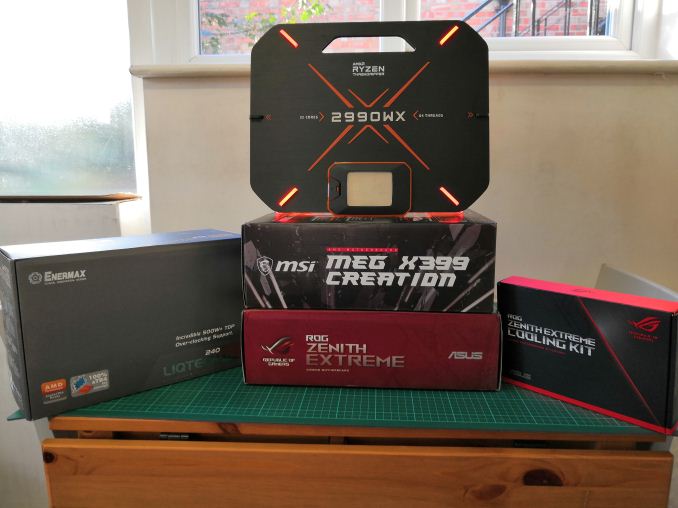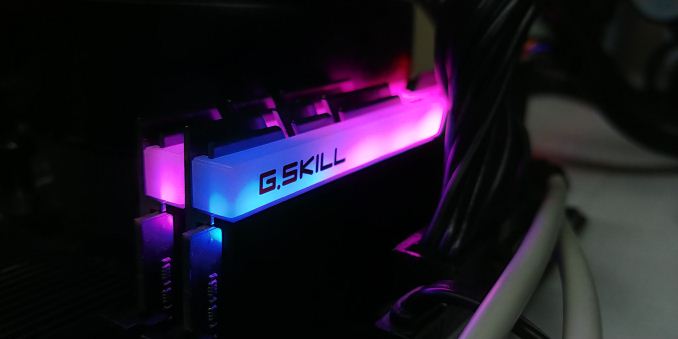The AMD Threadripper 2990WX 32-Core and 2950X 16-Core Review
by Dr. Ian Cutress on August 13, 2018 9:00 AM ESTTest Setup and Comparison Points
In our review kit from AMD, we were supplied with almost complete systems for testing. Inside the box of goods, AMD included:
- AMD Threadripper 2990WX (32C, 250W, $1799)
- AMD Threadripper 2950X (16C, 180W, $899)
- ASUS ROG Zenith Extreme motherboard, rev 2
- MSI X399 MEG Creation motherboard
- 4x8 GB of G.Skill FlareX DDR4-3200 14-14-14
- Wraith Ripper Cooler, co-developed with Cooler Master
- Enermax Liqtech 240 TR4 Liquid Cooler, rated to 500W
For our usual testing, we stick to the same power supplies, the same storage, ideally the same motherboard within a range of processors, and always use the latest BIOS. Despite AMD shipping us some reasonably fast memory, our standard policy is to test these systems at the maximum supported frequency as promoted by the processor manufacturer, or in this case DDR4-2933 for the new Threadripper 2000-series processors.
For our testing we compared the first generation Threadripper processors with the second generation parts. We also have the Intel 18-core Core i9-7980XE, some results from the Core i7-7900X (10-core), and also two mainstream processors, one Intel and one AMD. This is due to our new CPU testing suite, which takes effect today.
Due to an industry event occuring in the middle of our testing, we had to split some of the testing up and take 30 kg of kit half-way around the world to test in a hotel room during Flash Memory Summit. On the downside, it means there is some discontinuity in our testing, although not that much - on the plus side, the hardware tested in the hotel room had a good amount of air-conditioning to keep cool.
| AMD Test Setup | |||||
| CPUs | TR 2990WX | ASUS ROG Zenith | 0078 | Liqtech TR4 | 4x8GB DDR4-2933 |
| TR 2950X | ASUS ROG Zenith | 0078 | Liqtech TR4 | 4x8GB DDR4-2933 | |
| TR 1950X | ASUS X399-A Prime | 0806 | TRUE Cu | 4x4GB DDR4-2666 | |
| TR 1920X | ASUS ROG Zenith | 0078 | Liqtech TR4 | 4x8GB DDR4-2666 | |
| TR 1900X | ASUS X399-A Prime | 0806 | TRUE Cu | 4x4GB DDR4-2666 | |
| R7 2700X | ASUS Crosshair VI Hero | 0508 | Wraith Max | 4x8GB DDR4-2933 | |
| EPYC 7601 | GIGABYTE MZ31-AR0 | Fryzen | 8x128GB DDR4-2666 | ||
| GPU | Sapphire RX 460 2GB (CPU Tests) | ||||
| PSU | Corsair AX860i Corsair AX1200i |
||||
| SSD | Crucial MX300 1TB | ||||
| OS | Windows 10 x64 RS3 1709 Spectre and Meltdown Patched |
||||
The memory for our test suites was mostly G.Skill, with some Crucial. For the EPYC system, Micron sent us some LRDIMMs, so we fired up 1TB of memory to get all eight channels working.
On the Intel side, we are still getting up to speed on our testing.
| Intel Test Setup | |||||
| CPUs | i9-7980XE | ASRock X299 OC Formula | P1.40 | TRUE Cu | 4x8GB DDR4-2666 |
| i9-7900X | ASRock X299 OC Formula | P1.40 | TRUE Cu | 4x8GB DDR4-2666 | |
| i7-8700K | ASRock Z370 Gaming i7 | P1.70 | AR10-115XS | 4x4GB DDR4-2666 | |
| GPU | Sapphire RX 460 2GB (CPU Tests) | ||||
| PSU | Corsair AX860i Corsair AX1200i |
||||
| SSD | Crucial MX300 1TB | ||||
| OS | Windows 10 x64 RS3 1709 Spectre and Meltdown Patched |
||||
Over time we will be adding to our Intel CPUs tested.
Many thanks to...
We must thank the following companies for kindly providing hardware for our multiple test beds. Some of this hardware is not in this test bed specifically, but is used in other testing.
Thank you to Crucial for providing us with MX200 SSDs and to Micron for LRDIMMs. Crucial stepped up to the plate as our benchmark list grows larger with newer benchmarks and titles, and the 1TB MX200 units are strong performers. Based on Marvell's 88SS9189 controller and using Micron's 16nm 128Gbit MLC flash, these are 7mm high, 2.5-inch drives rated for 100K random read IOPs and 555/500 MB/s sequential read and write speeds. The 1TB models we are using here support TCG Opal 2.0 and IEEE-1667 (eDrive) encryption and have a 320TB rated endurance with a three-year warranty.
Further Reading: AnandTech's Crucial MX200 (250 GB, 500 GB & 1TB) Review
Thank you to Corsair for providing us with an AX1200i PSU. The AX1200i was the first power supply to offer digital control and management via Corsair's Link system, but under the hood it commands a 1200W rating at 50C with 80 PLUS Platinum certification. This allows for a minimum 89-92% efficiency at 115V and 90-94% at 230V. The AX1200i is completely modular, running the larger 200mm design, with a dual ball bearing 140mm fan to assist high-performance use. The AX1200i is designed to be a workhorse, with up to 8 PCIe connectors for suitable four-way GPU setups. The AX1200i also comes with a Zero RPM mode for the fan, which due to the design allows the fan to be switched off when the power supply is under 30% load.
Further Reading: AnandTech's Corsair AX1500i Power Supply Review
Thank you to G.Skill for providing us with memory. G.Skill has been a long-time supporter of AnandTech over the years, for testing beyond our CPU and motherboard memory reviews. We've reported on their high capacity and high-frequency kits, and every year at Computex G.Skill holds a world overclocking tournament with liquid nitrogen right on the show floor.
Further Reading: AnandTech's Memory Scaling on Haswell Review, with G.Skill DDR3-3000














171 Comments
View All Comments
jospoortvliet - Saturday, August 18, 2018 - link
https://www.phoronix.com/scan.php?page=article&... has some.nul0b - Monday, August 13, 2018 - link
Ian please define how exactly you're calculating and deriving uncore and IF power utilization.alpha754293 - Monday, August 13, 2018 - link
I vote that from now on, all of the CPU reviews should be like this.Just raw data.
Lolimaster - Monday, August 13, 2018 - link
To resume:Intel's TDP is a blatant lie, it barely keeps at TDP at 6c/6t, meanwhile AMD stick on point or below TDP with their chips, boost included :D
Lolimaster - Monday, August 13, 2018 - link
Selling more shares from $1.65 now to $19 :DAMD Threadripper 2, ripping the blue hole.
Lolimaster - Monday, August 13, 2018 - link
It seems geekbench can't scale beyond 16cores.Lolimaster - Monday, August 13, 2018 - link
WHERE IS CINEBENCH?Lolimaster - Monday, August 13, 2018 - link
And I mean CB15Also, for some reason CB11.5 MT seems to be broken for TR, it stops caling at 12cores.
mapesdhs - Monday, August 13, 2018 - link
CB R15 is suffering issues aswell these days, at this level it can exhibit huge variance from one run to another.eastcoast_pete - Monday, August 13, 2018 - link
Thanks Ian, great article, look forward to seeing the full final version!My conclusions: All these are workstation processors, NOT for gaming; the Ryzen 2700X and the upcoming Intel octacore 9000 series are/will be better for gaming, both in value for money and absolute performance. That being said, the TR 2950X could be a great choice, if your productivity software can make good use of the 16 cores/32 threads, and if that same software isn't written to make strong use of AVX 512. If the applications that you buy these monsters can make heavy use of AVX 512, Intel's chips are currently hard or impossible to beat, even at the same price point. That being said, a 2950X workstation with 128 or 256 Gb of RAM (in quad channel, of course), plus some fast PCIe/NVMe SSDs and a big & fast graphics card would make an awesome video editing setup; and, the 60 PCIe channels would come in really handy for add-in boards. One fly in the ointment: AMD, since you're hamstringing TR with only quad-channel, at least let us use faster DDR4; how about officially supporting > 3.2 Ghz?
Unrelated: Love the testing setup where the system storage SSD ( 1TB) is the same size as the working memory (1 TB). With one of these, you know you're in the heavyweight division.
@Ian: I also really appreciate the testing of power draws by cores vs. interconnecting fabric. I also believe (as you wrote) that this is a much underappreciated hurdle in simply escalating the number of cores. I also wonder a. How is that affecting ARM-based multicore chips, especially once we are talking 32 cores and up, as for the chips intended for servers? and b. Is that one of the reasons (or THE reason) why ARM-based manycore solutions have not been getting much traction, and why companies like Qualcomm have stopped their development? Yes, the cores might be very efficient, but if those power savings are being gobbled up by the interconnects, fewer but broader and deeper cores might still end up winning the performance/wh race.
If you and/or Ryan (or any of your colleagues) could do a deep dive into the general issue of power use by the interconnecting fabric and the different architectures, I would really appreciate it.